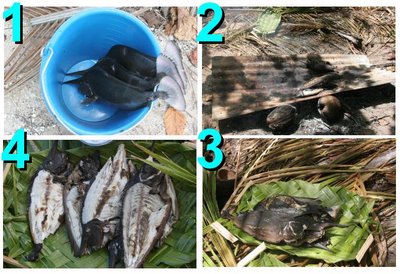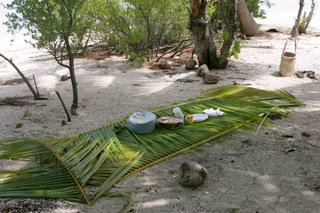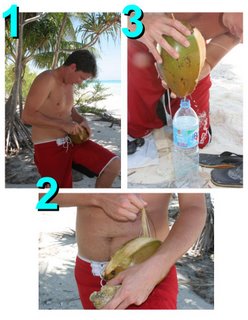
After our rainy summer in Paris, Xav and I were hoping and praying for better weather in New York City. Online weather reports promised us a week of cloudy days with temperatures hovering between 25°C to 29°C. We looked forward to our one-week discovery of the Big Apple. We left Paris on 28th August afternoon and arrived in JFK Airport at around 2:30pm the same day (crossing the date line, so minus 1 day).
By the time we arrived at our budget hotel on 71st St in Upper West Side Manhattan, it was 6pm and we were damp from the drizzling rain and tired from dragging two luggages and other carry-on bags. The Riverside Studios Hotel didn't look very appealing from the outside, yet the room we'd gotten was perfect – clean, with a double bed, mini-fridge and a fully-functional TV with a super clear reception. Bathrooms were squeaky clean and working – no clogged sinks or toilets. Location-wise, it was a great bargain. Right up the street is Central Park West. The hotel is two blocks away from the subway station and bus stand. There were plenty of shops and restaurants nearby. And it was relatively cheap compared to other budget hotels. We couldn't have asked for more.
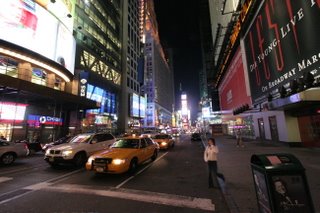

Even though Xav and I were tired, we still felt motivated to explore what we could of the night. We took the subway to Times Square. It was dusk and glittering lights began to appear all over the square. We saw huge, multi-coloured ads of all kinds (posters, billboards, LCD displays) perched on buildings and hanging down from poles. The streets were alive with people from all walks of life. Artists, cartoonists and caricaturists lined the sidewalks with their works leaning against several easels. Locals and tourists alike posed, sitting on tiny stools and grinning while their faces were being drawn.

There were bars, pubs and restaurants of all kinds – Italian, American, Irish, Indian, Chinese, etc. We were simply energized by the sights, sounds and smells coming from everywhere.
Our first American dinner was a slice of pizza at Pizza Famiglia.
Tip 1: Food in NYC is served in gargantuan portions. Yep, believe it or not, practically every meal that Xav and I ordered was too much for us! We either forced it down or left some uneaten. We learnt from this experience though – order one meal and share it. If we're still hungry later, we'll get a side order of fries :D.
Our days in NYC began with the morning weather reports.
Tip 2: Always always make time for the weather report! Apparently, a tropical storm called Ernesto was heading towards Florida that week. Thanks to Ernesto, we were hit with cloudy days and some light showers the whole week we were in NYC. Due to the drizzle that first morning, Xav and I decided to pay a visit to the American Museum of Natural History (AMNH), one of our must-see places in NYC.
Tip 3: Have an itinerary. This can sound boring, but unless you want to spend your days lost in the city without actually doing anything, planning what to do is the way to go. Xav and I planned our activities depending on the weather. We spent rainy days in covered areas like museums or historical buildings and sunny days outside in parks or walking the streets of Manhattan. We also had a specific list of must-see places and must-do things.
Since the AMNH was close to our hotel, we took a nice long walk along Central Park that morning. As we stopped at a street corner to have a look at the map, an old man approached us and asked if we were looking for John Lennon. He had a very strong Texan accent and looked rather pink in the face, so we just assumed that he was drunk, although it was only 9am at the time. We replied instead that we were looking for the museum and he pointed us in the right direction. It was only a few days later when we realized what that old man had actually meant.

There is a tribute to John Lennon situated in Central Park. It is a 2.5-acre teardrop-shaped landscape called
Strawberry Fields, named after Lennon's song 'Strawberry Fields Forever'. Within this landscape is a mosaic of the song title 'Imagine'. This mosaic was made by Italian craftsmen and brought in from Naples as a gift in honour of the great Beatles member.

The museum was not yet open when we arrived, so we walked to a nearby cafe for a shot of caffeine (I can't survive the morning without one!). Not to be a snob, but having been exposed to French-made coffee, it was difficult to stomach the bland, watery concoction that Americans call coffee. It sloshed convincingly in a thick 12 oz paper cup and I was fooled into taking a sip, only to crunch up my face in distaste soon after. We didn't stay long here.



The AMNH is amazing! I'd recommend it to everyone. There are five floors, covering displays and exhibitions of everything related to our world, from outer space to dinosaurs to modern civilizations. We started with a show entitled 'Cosmic Collisions' at the Hayden Planetarium Space Theater. From there, we moved on to the wonderful museum displays. Instead of displaying fake, man-made animals, the museum had stuffed animals that were once alive. It was not just the animals that seemed real. Background paintings of wildlife sceneries and the prop settings in each display are so realistic you are compelled to feel that these animals were captured in their natural state. Even the water ripples are carefully designed, as though the tiger really was drinking from the little stream.

Of course, the biggest wonder of all for Xav and I was the fourth floor dinosaur displays. These were magnificent sights to behold as we walked down each aisle, trying to read the vast collection of information about every dinosaur. There was even one section which compared dinosaur species against the animals that we have today, with detailed explanations of the similar physical characteristics that still exists across the ages.

We spent the day at the museum, since we could not finish seeing everything (in fact, we still didn't!). Since the rainy weather persisted through the next day, Xav and I visited another must-see place – the Metropolitan Museum of Art (MET).

Truth be told, I'd expected more from this museum, but this is probably because I compare it to the Louvre Museum in Paris. We walked through the modern art section, sceptical at these works being called art. Okay, I'm not an artist so I find it hard to find the beauty in certain pieces of modern art. Come on, some on them look like paints thrown onto a canvas! Nevertheless, there was a photography exhibition that was pretty good and the museum does hold some works of famous painters like Monet and Van Gogh.

Surprisingly, the MET also had sections that displayed armoury and weaponry from different civilizations. There was a stunning collection of swords, knives, pistols and rifles and even armoury for horses. The MET showed musical instruments as well and in some displays, you could actually imagine the evolution of the instrument from then until now. There were several single box-displays too, explaining how astrology and time were calculated, showing a complete set of women's jewellery and the various types of chalices that existed centuries ago. Several beautiful frames and designs of religious stained glasses hung all over the museum walls.


Some sections carried carvings of the Virgin Mary and Jesus Christ. There were little tribal statues and puppets from other civilizations on display in another part of the MET. One little statue was of a couple where the man had his arm around his woman. If you look closely in the photo, you can see the the statues are anatomically correct ;D.
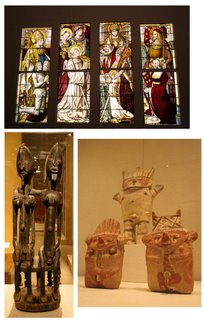
We spent the morning here and yet not being able to see everything. I think this is impossible to do in even one full day, so I suppose we'll have to return for a second look in the future ;D.
Aside from visiting the museums, we spent our days in NYC walking the streets of Manhattan.
Tip 4: Grab literature. We had our trusty Lonely Planet guidebook, and it contained maps of the neighbourhood and subway routes. When we visited the Grand Central Terminal, we picked up a free weekly city guide (NYC Official City Guide) which had a map for the bus routes. This little book is wonderful, naming restaurants to dine at and flea markets to visit.

Another useful magazine to have is called 'Time Out New York'. This is a weekly magazine and is full of information on everything to do, from stand-up comedies to concerts to exhibitions. Thanks to this magazine, Xav and I did a lot of things during the nights – improvisation comedy routine, jazz bars and flea markets. In fact, just thumbing through the magazine, we wished we had more time to do everything listed there! It's amazing how any New Yorker gets anything else done in his or her life, what with all the animations and hosts of activities going on in NYC.
 Tip 5: Wear comfortable shoes.
Tip 5: Wear comfortable shoes. Armed with our maps, Xav and I did a lot of walking tours by ourselves. We selected neighbourhoods to explore for the day and were on our way. Towards the end of the week, my Reeboks began to fall apart. I purchased a new pair in SoHo just when the front seams of my old shoes started to tear. We managed to do almost everything – the Financial District, Chinatown, Little Italy, SoHo, TriBeCa, Greenwich Village, East and West Villages, Chelsea, Midtown and Upper Manhattan. We even took a roller coaster ride in Astroland Park, Coney Island. Each area had its own distinct culture, landscape and architecture.

The Financial District towers over you with its many skyscrapers. Here, you are in the shadows of serious-looking financial experts, men and women walking briskly in their power suits carrying fashionable briefcases. You feel time is precious (or rather, time is money). Of course, Xav and I visited Ground Zero. The absence of something grand amidst the surrounding tall buildings can definitely be felt. We saw an exhibition area which highlighted photographs taken during the unfortunate 9/11 incident. There was also a brief introduction and explanation about the construction of 'Freedom Tower', a 1776-foot building to replace the original twin towers at the site.

Xav and I stood amongst strangers and yet I'm certain that we all shared the same sentiments. A hush of contemplation and sadness fell over us as we looked at photos of the 9/11 destruction. Later, Xav and I walked over to St Paul's Chapel nearby. The church was the center of relief efforts for eight months after 9/11. There were several small memorials that held photos of loved ones and nationwide letters of sympathy. Candles were lit for the souls lost on that fateful day.

Like I mentioned above, each neighbourhood has its own unique characteristics. While the Financial District is orderly and imposing, Chinatown's shops are messy, small and crowded together. Chinese dialects of all kinds are shouted over your head and across the streets. You will see the same array of goods that you can find in Petaling Street, KL. Every business name is written in both English and Chinese. Further up the streets, Little Italy brings its own European touch with its classy restaurants and charming atmosphere. You can see the Italian flag flying from many windows and streetlight poles. The green, white and red colours of the flag are displayed everywhere – perhaps the Italians were still celebrating their World Cup win.

The hippest and most colourful neighbourhood that we went to was the East Village. There are colourful murals on several walls of cafes, restaurants, pubs and bars. The shops sell vintage clothes, music records and books. Xav and I did quite a bit of shopping here. He bought some used CDs and I got myself some clothes on summer sale.

We waited for really good weather before visiting other famous buildings like the Empire State Building (ESB) and the Statue of Liberty (SoL). Unfortunately, the weather remained the same, so we cancelled the trip to SoL and tried for the ESB instead. We wanted to take sunset shots so we left for the ESB around 5pm. Fortunately we went early as the queue was incredibly long! Even with quick ticketing service, we had to wait at least an hour before taking the lift to the top. Xav and I didn't go to the highest level (102nd Fl) since it was really expensive and we felt that it wouldn't have made so much of a difference to the view anyway. From the 86th Fl, the views were fantastic, both before sunset and during sunset. Take a look......
In the first half of the week, Xav and I took subways or walked to wherever we wanted to go. Finally, we decided to take buses, just for the sake of experience.
Tip 6: Save on Metro Card. Instead of paying US$2 per subway or bus trip in one direction, we bought two 7-day Metro Cards for the price of US$48 (US$24 per person). This card allows us 7 days of unlimited travel on all subways and buses for all directions in NYC. It's really worth it, trust me!
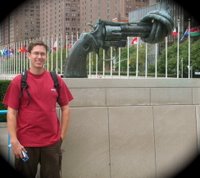
Buses are fun because you get to see everything that you pass by, unlike subways which are all underground. We took the bus to go the United Nations building. We didn't go inside, of course, just snapped some photos outside. Xav is standing by this tied pistol called 'Non-Violence' and this big golden sphere was originally at the World Trade Center and hence, partially destroyed on 9/11.
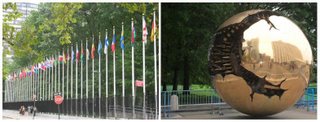
Our last days in NYC was spent walking down Fifth Avenue. We didn't enter any of the shops, although we did sneak peeks through the windows. We learnt our lesson from our one trip to Barney's New York on the Upper East Side. We'd seen a sale advertisement for Barney's and decided to go over there, thinking we could get ahold of designer clothing at sale prices. Yeah right!! The cheapest item we saw there was a T-shirt for about US$300! And it didn't even look good.

So, Xav and I went to a flea market nearby our hotel. We didn't buy anything here, but we got an eyeful of a lot of nice things. One guy was selling posters from the 60's and 70's at prices starting from US$50. These were really nice posters. Apparently, there was a family who collected these posters from 9 cinemas all over NYC. They kept them in mint condition throughout the years. Some of the better looking posters cost about US$200 to US$300 each. There were also other things more commonly found in most flea markets – flowers, jams, fruits. One Punjabi guy was selling rugs, carpets and wall hangings from India. He didn't want to be in the photo however, but we had a nice chat. He could tell that I was half-Indian, believe that or not! :D

Xav and I accidentally walked into another market (I can't even remember where!) and found that it was just like all the
pasar malam we have in Malaysia. There were tons of food everywhere, along with items like clothes, books, fridge magnets, statuettes, etc. People were jammed in like sardines so it felt like we were salmons swimming upstream. We found more old posters here, but these were smaller in size.

There was also a crowd gathered around some breakdance music. Curious, Xav and I went to watch this street performance. We had already seen something like this at Battery Park City. These street performers will rap or dance and then at the end of it, will walk around asking for donations from the crowd. Once, some people walked away right after the 'show' and the guy actually commented out loud, laughing while jokingly begging them to stay. At Times Square, a band played some songs which later turned out to be the band's own way of promoting their new album.

On our very last morning, after checking out of the hotel, Xav and I went to Upper East Side to taste the famous frozen chocolate at Serendipity III. Lonely Planet did not mention this place, but we found out about it in another guidebook (we had to buy a new one because we lost our LP). The evening before, we'd wanted to go there for dessert. The line was right out on the sidewalk! Through the open door, we spied some heads in another line right up to the counter. Beyond the counter, there was another line to the reception. Basically, there were about 50 people just waiting to be seated. And God knows how many more already seated inside, enjoying their dessert. So, Xav and I thought that we could come back early the next morning for a last try before leaving NYC. Lo and behold, when we arrived at 10:30am, there was already a line waiting outside! Serendipity III was only opening at 11:30am that day, so Xav and I had to give up the taste since we were supposed to leave for the airport by then. Maybe next time......

The NYC trip is an unforgettable one.
Tip 7: Smile. Not only are the places rich with culture and animation, New Yorkers are very very friendly, chatty people. If you ever want to be alone, then never open a map or guidebook on the streets. Within seconds, a New Yorker will come right up to you and give you detailed directions, name of streets, how the street curves and what landmarks to look for. And if that's not enough, they'll also advise you where to go and what to see. Somewhere in the middle of all this, they'll ask where you're from and how you like it in their city. Xav and I never had the opportunity to learn their names, but we have never felt more welcomed and acknowledged in a city this immense. We felt truly sad to leave but are absolutely certain that we would visit the Big Apple again.
 I’ve been wanting to write about La Côte de Granit Rose (The Pink Granite Coast) since I arrived in Lannion, but so many events have occurred that it feels like I’m running a race against time these last few months!!
I’ve been wanting to write about La Côte de Granit Rose (The Pink Granite Coast) since I arrived in Lannion, but so many events have occurred that it feels like I’m running a race against time these last few months!! Which is exactly what Xav and I did that day! It’s odd how comfortable these ‘seats’ are, and if you lie down on one of the larger rocks, you feel your back curving smoothly and easily along the lines of the rock. Simply convenient if you want to read a book while being surrounded by nature :-D . We took this opportunity to capture a little ‘family’ picture – our first, in fact, in France.
Which is exactly what Xav and I did that day! It’s odd how comfortable these ‘seats’ are, and if you lie down on one of the larger rocks, you feel your back curving smoothly and easily along the lines of the rock. Simply convenient if you want to read a book while being surrounded by nature :-D . We took this opportunity to capture a little ‘family’ picture – our first, in fact, in France. If you look closely enough, you may see the rocks take the shape of animals or things. But you need to be attentive and I suppose, have the eye to spot such things. Xav and I didn’t spot anything except for what has been shown to us before by a colleague of Xav’s when he took us and some Pakistani trainees on a quick tour of the coast. For instance, in the photo here, you may be able to see a seashell-shaped rock balancing somewhat precariously on another rock. All the horizontal rocks look like their hanging by a very thin edge, but in actual fact, they are sitting on about a metre’s width on other rocks. But still, given the size of these rocks, I won’t be surprised if one day, some of them teeter off onto the ground!!
If you look closely enough, you may see the rocks take the shape of animals or things. But you need to be attentive and I suppose, have the eye to spot such things. Xav and I didn’t spot anything except for what has been shown to us before by a colleague of Xav’s when he took us and some Pakistani trainees on a quick tour of the coast. For instance, in the photo here, you may be able to see a seashell-shaped rock balancing somewhat precariously on another rock. All the horizontal rocks look like their hanging by a very thin edge, but in actual fact, they are sitting on about a metre’s width on other rocks. But still, given the size of these rocks, I won’t be surprised if one day, some of them teeter off onto the ground!! Anyway, Xav and I took Alto with us on a walk at this coast. It is impossible to let him run free here since there are too many people, especially on a day when there is good weather. But when we are able to, we do let him go and he goes crazy climbing over every rock and sniffing every pool of fresh water. There are tadpoles in the water sometimes and he gets attracted by their very rapid movement. We passed by this one particular rock that looks like a surfboard. Both Xav and I climbed it just to pose for a ‘surfing’ photo. It can be quite scary as there are no footholds on the rock below, and once on it, all you see right next to you on the other side is a high cliff, menacing rocks below and waves of sea water crashing over them. At the time we took the photo, the wind was blowing very very hard, enough to knock you off balance if you weren’t quick enough to react. Rather scary, which was why I decided to sit down instead. After all, I was two months pregnant at the time! Alto, obviously, was not happy at all, seeing us up there. I think, it’s not so much for our safety that he barked furiously, but more the fact that he couldn’t possibly climb up such a high rock :-D .
Anyway, Xav and I took Alto with us on a walk at this coast. It is impossible to let him run free here since there are too many people, especially on a day when there is good weather. But when we are able to, we do let him go and he goes crazy climbing over every rock and sniffing every pool of fresh water. There are tadpoles in the water sometimes and he gets attracted by their very rapid movement. We passed by this one particular rock that looks like a surfboard. Both Xav and I climbed it just to pose for a ‘surfing’ photo. It can be quite scary as there are no footholds on the rock below, and once on it, all you see right next to you on the other side is a high cliff, menacing rocks below and waves of sea water crashing over them. At the time we took the photo, the wind was blowing very very hard, enough to knock you off balance if you weren’t quick enough to react. Rather scary, which was why I decided to sit down instead. After all, I was two months pregnant at the time! Alto, obviously, was not happy at all, seeing us up there. I think, it’s not so much for our safety that he barked furiously, but more the fact that he couldn’t possibly climb up such a high rock :-D . A few more minutes walk from this ‘surfboard’ rock, is the lighthouse of the coast. It’s made of rocks in the 17th century, which were mounted and melded together with sand. It is typical of other rock buildings along the path – one was built for a little lookout during the war, and the other was to keep gunpowder. Unfortunately, I didn’t discover these two little buildings until later, when I didn’t have the camera with me, so sorry folks, no photos! I find it amazing that these century-old buildings actually lasted through the war, through wind and water erosion, and are still standing upright. Our buildings today are already collapsing around us after 20 years! For some apartments, you can even see the cracks in the wall after the third year.
A few more minutes walk from this ‘surfboard’ rock, is the lighthouse of the coast. It’s made of rocks in the 17th century, which were mounted and melded together with sand. It is typical of other rock buildings along the path – one was built for a little lookout during the war, and the other was to keep gunpowder. Unfortunately, I didn’t discover these two little buildings until later, when I didn’t have the camera with me, so sorry folks, no photos! I find it amazing that these century-old buildings actually lasted through the war, through wind and water erosion, and are still standing upright. Our buildings today are already collapsing around us after 20 years! For some apartments, you can even see the cracks in the wall after the third year. Since we did this tour every time we have a visitor over to our house, I combined a few photos taken at different times. As the lighthouse stands majestically facing the sea, you can see the difference in the landscape during a rainy or stormy weather and one when the sun shines brightly. The sea always remains a mystery to me. Only God knows what secrets it keeps within its darkness and depth.
Since we did this tour every time we have a visitor over to our house, I combined a few photos taken at different times. As the lighthouse stands majestically facing the sea, you can see the difference in the landscape during a rainy or stormy weather and one when the sun shines brightly. The sea always remains a mystery to me. Only God knows what secrets it keeps within its darkness and depth. Despite the fact that we didn’t stop to eat by the beach, Xav nevertheless took a shot of two of his favourite girls – my mother-in-law Elizabeth and moi, bien sûr! It was a lovely day spent at a place of truly natural beauty that refreshed our spirits to the very core of our being. When you stand before such elegance and magnificence, you can’t help but sigh in contentment and of course, of wonder.
Despite the fact that we didn’t stop to eat by the beach, Xav nevertheless took a shot of two of his favourite girls – my mother-in-law Elizabeth and moi, bien sûr! It was a lovely day spent at a place of truly natural beauty that refreshed our spirits to the very core of our being. When you stand before such elegance and magnificence, you can’t help but sigh in contentment and of course, of wonder.



















